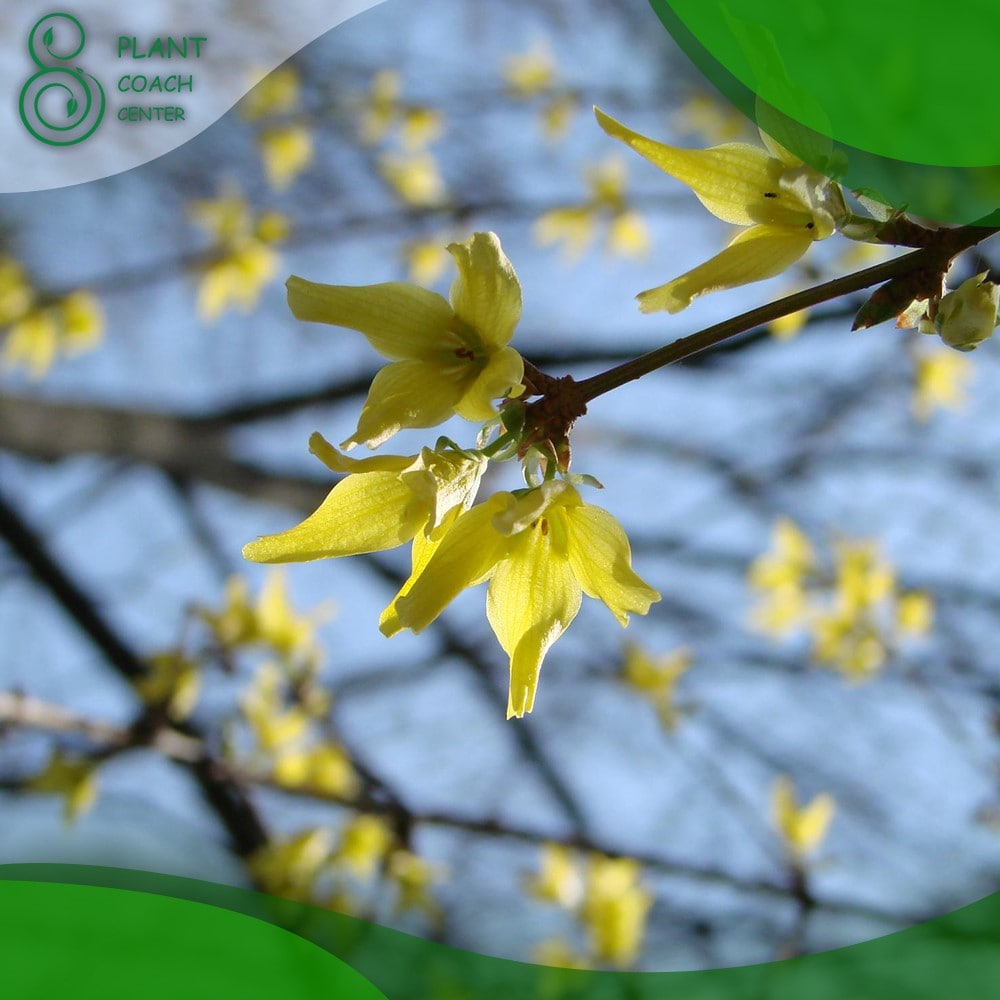Introduction to When to Prune Forsythia
Forsythia bushes, with their radiant yellow blossoms, have long been a beloved staple in gardens across the globe. Their striking appearance heralds the arrival of spring and infuses landscapes with a burst of vibrant color. Whether you’re a seasoned gardener or just starting out, forsythia’s appeal is undeniable. Yet, amidst their beauty lies a crucial secret: proper pruning is the key to keeping these shrubs healthy and thriving.
The timing of this pruning is paramount, and In this article of plantcoachcenter.com, we’ll delve into when precisely you should pick up those pruning shears. Knowing when to prune forsythia bushes is more than just a gardening tidbit; it’s the difference between a flourishing spring spectacle and a lackluster display. So, let’s embark on this journey to uncover the optimal moments for pruning these stunning garden gems.
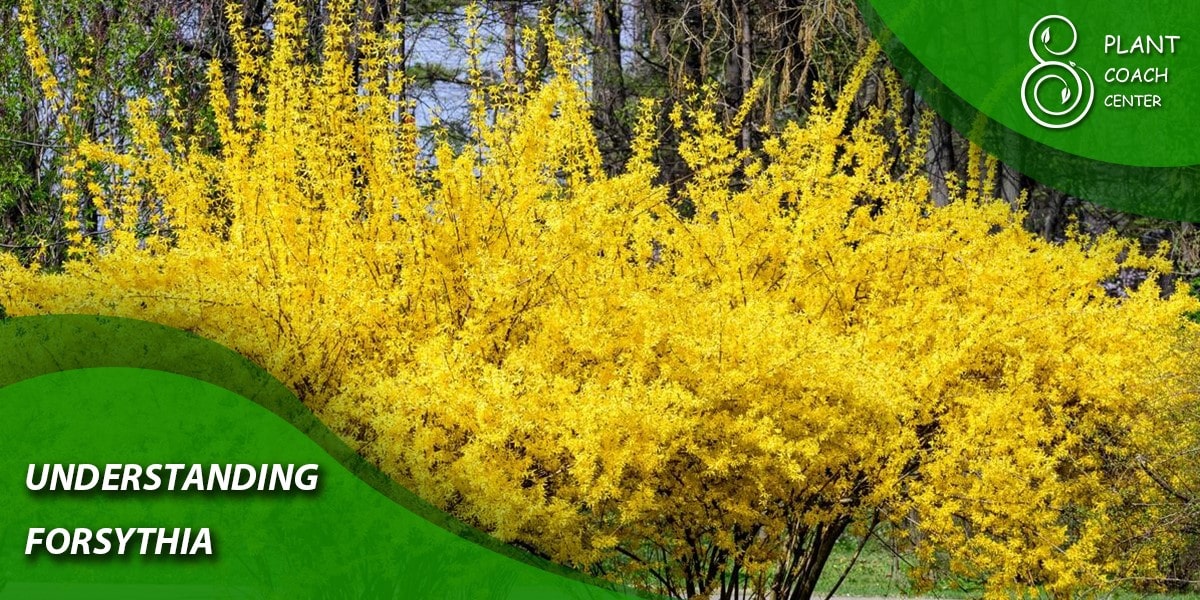
Understanding Forsythia
Characteristics of Forsythia Bushes
Forsythia bushes, scientifically known as Forsythia x intermedia, are deciduous shrubs celebrated for their distinctive features. These hardy plants are renowned for their vibrant yellow flowers that adorn their arching branches, creating a stunning spectacle in early spring. Forsythia flowers are typically four-petaled and grow in profuse clusters, transforming the landscape into a sea of bright yellow hues.
Forsythia bushes boast a moderate growth rate and can reach heights ranging from 6 to 10 feet, with a similar spread. Their foliage consists of simple, elliptical leaves that are dark green in color during the growing season, providing a lush backdrop for the flowers.
Why Forsythia Bushes Require Pruning
Pruning forsythia bushes is not just a matter of aesthetics; it plays a crucial role in maintaining their overall health and appearance. Here’s why:
Flower Production: Forsythia bushes produce flowers on wood that’s one year old. Over time, the oldest branches become less productive, leading to reduced flowering. Pruning helps remove old wood, stimulating the growth of new branches that will bear an abundance of flowers.
Shape and Size: Forsythia bushes have a tendency to grow tall and leggy if left unchecked. Pruning helps control their size and shape, ensuring they maintain a compact and attractive form.
Air Circulation and Disease Prevention: Dense, overgrown foliage can trap moisture, creating an environment conducive to disease and pests. Pruning opens up the interior of the bush, improving air circulation and reducing the risk of fungal infections and infestations.
Renewal: Forsythias can become woody and unattractive over time. Pruning encourages the growth of new, vigorous shoots, rejuvenating the bush and revitalizing its visual appeal.
In essence, pruning is a vital tool in ensuring that your forsythia bushes remain not only visually stunning but also robust and resilient in the face of potential challenges.
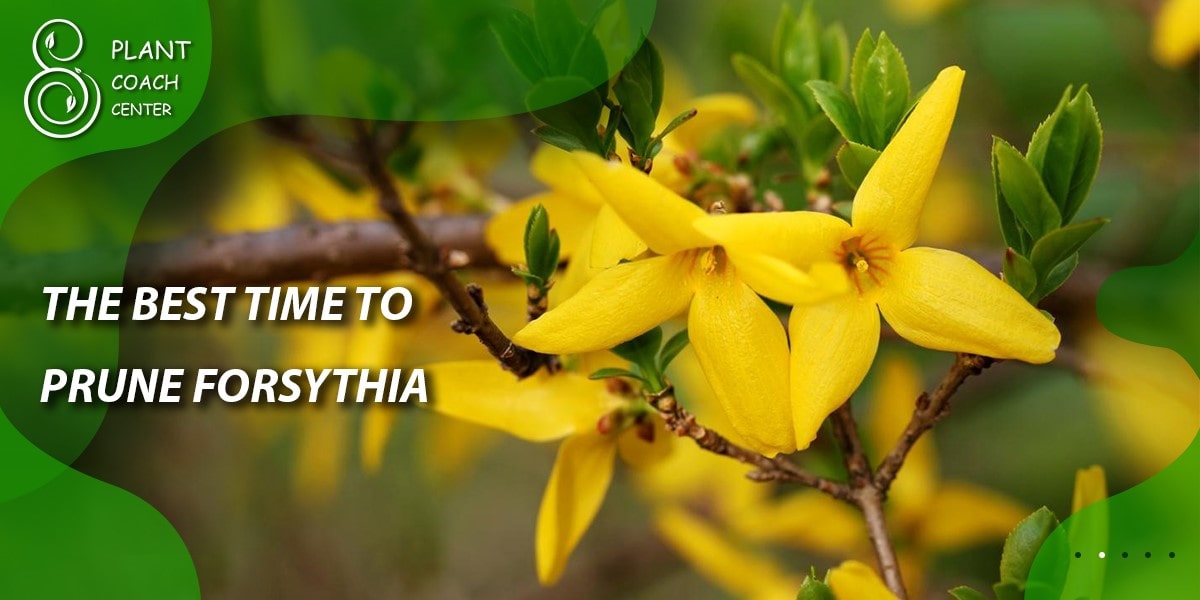
The Best Time to Prune Forsythia
Early Spring Pruning
Early spring, that magical time when the world awakens from winter’s slumber, is the prime window for pruning your forsythia bushes. This timing is no coincidence; it’s rooted in the biology of the plant and the optimal conditions for encouraging healthy growth and abundant blooms.
Why Early Spring is Ideal:
In early spring, forsythia bushes are on the cusp of awakening from their winter dormancy. This is a pivotal moment because it’s just before new growth begins. By pruning during this brief window, you harness the plant’s natural energy and direct it to the branches you want to encourage.
The Crucial Timing Aspect:
Here’s the kicker: pruning before new growth begins is crucial. If you wait too long into spring, the forsythia will have already started putting energy into new shoots and buds. Pruning at this point disrupts the natural growth cycle and can lead to a reduction in flowering. So, think of early spring pruning as a precision operation, where timing is everything.
Late Winter Pruning
Now, if you happen to live in regions with mild winters, there’s a small window in late winter where you can also consider pruning your forsythia. However, it’s a delicate balancing act.
Late Winter Pruning Considerations:
Late winter pruning can be an option for regions where the forsythia bushes don’t experience severe cold temperatures. It’s typically done in late February to early March, just before the plant starts showing signs of new growth.
The Fine Line:
But here’s the catch: you must avoid pruning too late into late winter. If you miss the narrow window and prune when buds are about to burst, you risk cutting off those future blossoms. It’s a tightrope walk, and timing here is equally critical. Pruning too late defeats the purpose and can result in diminished flowering.
So, whether it’s early spring or late winter, timing is the linchpin when it comes to pruning forsythia bushes for optimal growth and that breathtaking burst of yellow in the spring.

Why Timing Matters
Timing isn’t just a minor detail when it comes to pruning forsythia bushes; it’s the linchpin that can either make or break the health and vibrancy of your beloved shrubs.
Impact of Improper Timing on Forsythia Health and Flowering
Imagine this scenario: you decide to prune your forsythia bushes haphazardly, without paying attention to the season. What happens next is a ripple effect of consequences.
When you prune at the wrong time, you disrupt the natural growth cycle of the forsythia. If you prune too late in spring or, even worse, during the summer or fall, you risk removing the buds and wood that would have produced those stunning yellow blooms in the following spring.
Additionally, improper timing can weaken the forsythia’s overall health. Cutting away during the wrong season can stress the plant, leaving it vulnerable to disease and insect infestations. This, in turn, can lead to a decline in the bush’s vigor and resilience.
Reduced Blooms in the Following Spring
The most noticeable repercussion of improper timing is a stark reduction in the number of blossoms you’ll see in the upcoming spring. Forsythias, as mentioned earlier, flower on wood that’s a year old. If you prune during the wrong season, you’re essentially removing the potential for those new blooms.
In essence, the show-stopping display of bright yellow flowers that you eagerly anticipate each spring may be significantly muted or even absent. Instead of a lush, radiant canopy of blossoms, you might be greeted with sparse and lackluster flowering, leaving you with a garden that falls far short of its potential.
In summary, timing isn’t an arbitrary guideline but a critical factor in preserving the health and ensuring the breathtaking beauty of your forsythia bushes. Pruning at the right time is an investment in the future vibrancy of your garden.
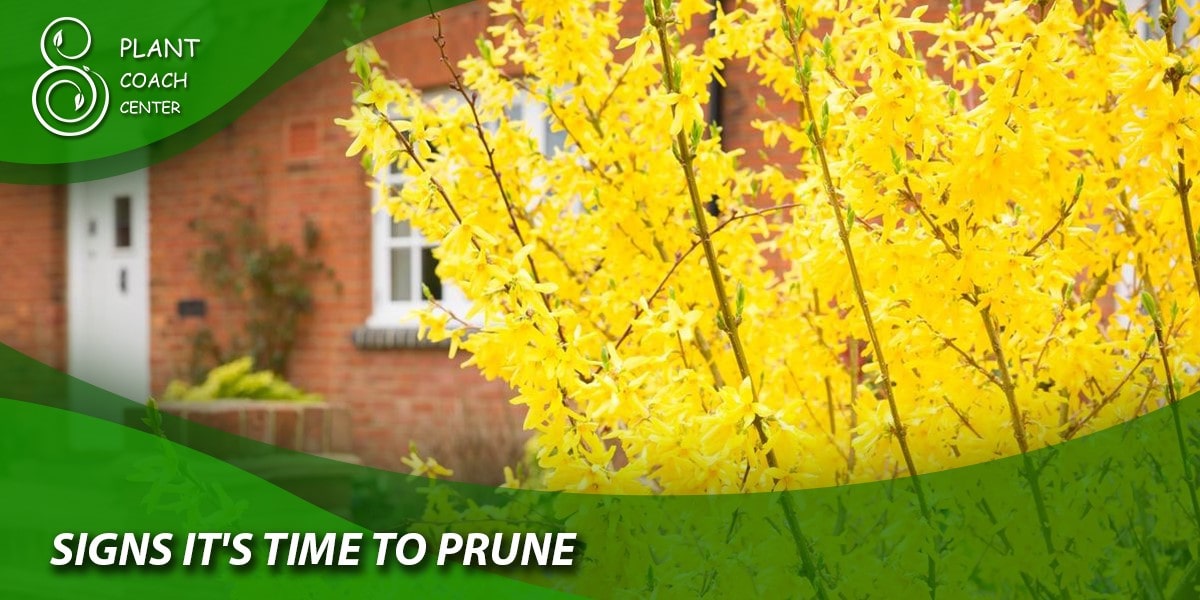
Signs It’s Time to Prune
Pruning your forsythia bushes at the right moment is key to their overall health and vitality. Fortunately, nature provides us with some clear visual cues to help determine when it’s time to pick up those pruning shears.
Lackluster Blooms:
The first and most obvious sign is the quality of the blooms. If you notice that the forsythia’s flowering has become less vibrant and bountiful compared to previous years, it’s a clear indicator that pruning is in order. Sparse or smaller blooms can signify that the bush has an excess of old wood that needs removal.
Overgrown Appearance:
When your forsythia bush begins to look unruly and overgrown, it’s another telltale sign that it’s time for some pruning. If the bush has lost its well-defined shape and looks messy, it’s best to trim it back to restore its natural form.
Crowded Growth:
Inspect the interior of the bush. If you observe a tangle of branches, with some crossing over each other, it’s a sign that air circulation within the bush is poor. This can lead to increased vulnerability to diseases and pests, making it necessary to prune for improved airflow.
Dead or Dying Wood:
Any branches that appear dead or diseased should be promptly removed. Pruning these branches not only enhances the bush’s appearance but also prevents potential health issues from spreading.
New Growth Emergence:
On the flip side, if you notice new green shoots starting to sprout, it’s a signal that the forsythia is coming out of dormancy. This is the ideal time for early spring pruning, as mentioned earlier. Pruning before these new shoots grow too vigorously ensures that the plant directs its energy where you want it.
Encourage Regular Inspection:
Lastly, to catch the right moment for pruning, it’s essential to make regular inspections of your forsythia bushes. By keeping a watchful eye on the plant throughout the year, you’ll be better equipped to spot these visual cues as they develop. Remember, it’s not just about pruning; it’s about nurturing your forsythia to ensure it continues to thrive and grace your garden with its stunning display.
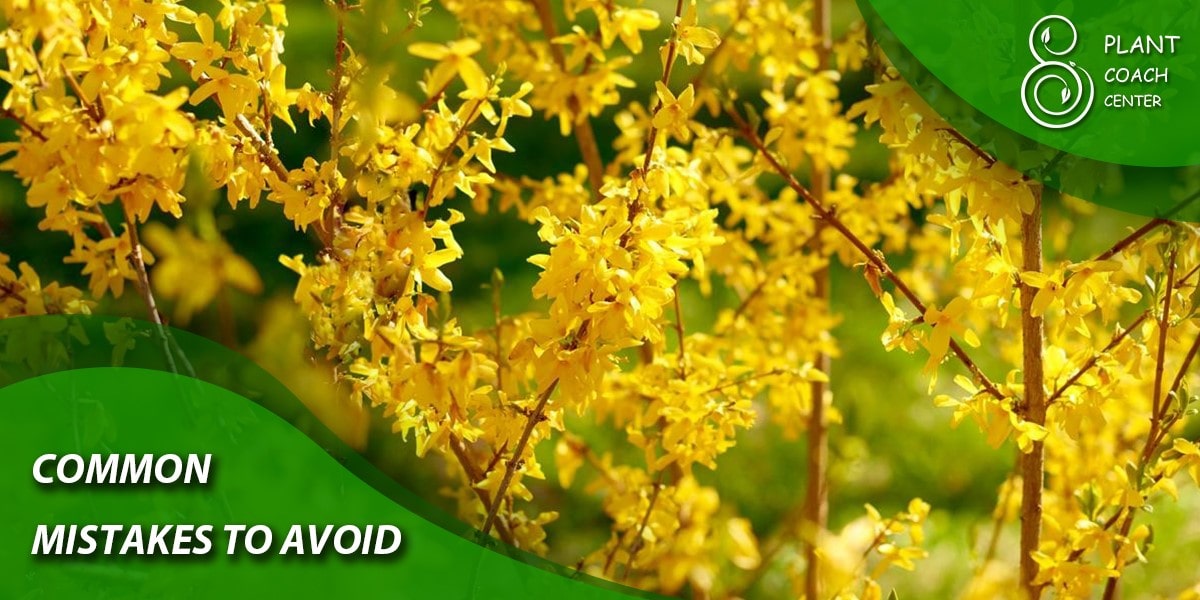
Common Mistakes to Avoid
When it comes to pruning forsythia bushes, there are certain pitfalls that even the most well-intentioned gardeners can stumble into. To keep your forsythia thriving and resplendent, it’s crucial to steer clear of these common missteps.
Over-Pruning:
One of the most prevalent mistakes is over-pruning. Some gardeners, in their eagerness to shape their forsythia or control its size, can go too far, cutting back more than is necessary. This overzealous approach can lead to a host of issues.
Consequences of Over-Pruning:
Reduced Blooms: Over-pruning removes too much of the previous year’s growth, which is where the forsythia produces its flowers. As a result, you might witness a dramatic reduction in the number of blooms the following spring.
Stunted Growth:
Cutting back excessively can weaken the plant by hindering its ability to photosynthesize and store energy. This can lead to stunted growth and an overall less robust forsythia.
Unsightly Appearance:
Over-pruning can leave your forsythia looking awkward and sparse. Instead of enhancing its aesthetic appeal, it can result in a rather unsightly and unhealthy appearance.
Pruning During the Wrong Season:
Another misstep to avoid is pruning during the wrong season. Pruning at the improper time can disrupt the forsythia’s natural growth cycle and have detrimental effects.
Consequences of Pruning at the Wrong Time:
Loss of Blooms: Pruning too late in the spring or during the summer and fall can remove the wood that would have produced flowers in the next spring. This means you might miss out on the characteristic burst of yellow.
Weakened Bush: Pruning when the forsythia is actively growing can stress the plant and leave it susceptible to diseases and pests. This can weaken its overall health.
Messy Appearance: Cutting at the wrong time can lead to an unkempt and untidy appearance, as new growth might emerge haphazardly without the chance to develop a natural shape.
In conclusion, over-pruning and pruning at the wrong season are common mistakes that can have adverse effects on your forsythia bushes. By avoiding these pitfalls, you can ensure that your forsythia not only survives but thrives, gracing your garden with its vibrant presence each spring.
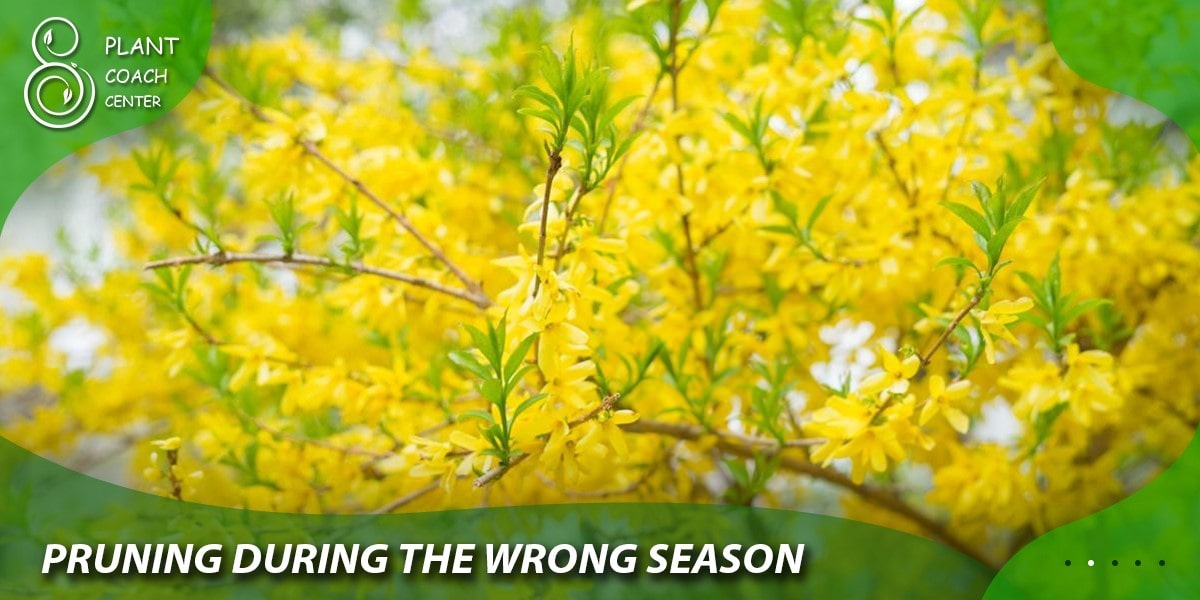
Conclusion
Timing is the essential cornerstone when it comes to pruning forsythia bushes. Prune in early spring, just before new growth emerges, to unlock the full potential of these vibrant shrubs. Proper timing ensures healthy growth, abundant blooms, and a well-maintained appearance.
However, beware of common mistakes like over-pruning or trimming at the wrong season, which can lead to reduced flowering and weakened bushes. Remember, timing isn’t a mere detail; it’s the bedrock upon which the health and beauty of your forsythia bushes flourish.
FAQs
Can I prune forsythia in summer?
Avoid summer pruning; opt for early spring or late winter.
How much should I prune?
Remove about one-third of the oldest wood; don't over-prune.
Can I prune mature forsythia?
Yes, in early spring, mature bushes benefit from rejuvenation.
When should I inspect for signs to prune?
Regularly check for signs like lackluster blooms or crowded growth.
What if I prune too late?
Pruning too late can reduce spring blooms; avoid it.
What if I prune too early?
Pruning too early risks frost damage; time it carefully.


